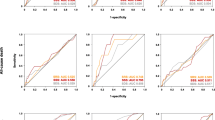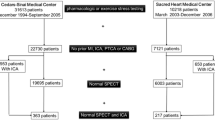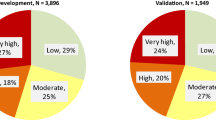Abstract
Background. The extent and severity of stress ischemia are strong predictors of coronary artery disease (CAD) events. Prognosis associated with myocardial perfusion single photon emission computed tomography (MPS) abnormalities on the resting scan as it relates to stress ischemia has been incompletely described.
Methods and Results. The Myoview Prognosis Registry was a prospective consecutive series of 7849 outpatients enrolled from 5 geographically diverse centers. Patients were followed up for the occurrence of CAD events (nonfatal myocardial infarction [MI] or death related to MI, heart failure, or sudden cardiac death). Time to CAD event (n=545) was estimated by use of univariable and multivariable Cox proportional hazards models (risk adjusted by symptoms, risk factors, and comorbid conditions). For patients with no resting defects, overall CAD event rates were 1.2%, 8%, and 10% for patients with 0% ischemic myocardium, 1% to 4.9% ischemic myocardium, and 5% ischemic myocardium or greater, respectively (P<.0001). As the percent myocardium with resting defects worsened, overall CAD event rates increased, such that for patients with 10% or more of the rest myocardium with perfusion defects, cardiovascular death or MI rates ranged from 7% to 44% (P<.0001). In a model including both the percent of the myocardium with resting defects and the percent ischemia, both were highly predictive of CAD events (P<.0001). For every 1% increase in ischemic myocardium, there was a 7% increased risk of CAD events (P<.0001). A 3% increase in risk of CAD events was observed for patients with every 1% of the myocardium with resting defects (P<.0001).
Conclusions. The estimation of CAD risk may be optimally estimated by use of a combination of resting MPS, reflecting a patient’s burden of disease, and MPS with provocative ischemia.
Similar content being viewed by others
References
Shaw LJ, Iskandrian AE. Prognostic value of stress gated SPECT in patients with known or suspected coronary artery disease. J Nucl Cardiol 2004;11:171–85.
Klocke FJ, Baird MG, Lorell BH, Bateman TM, Messer JV, Berman DS, et al. ACC/AHA/ASNC guidelines for the clinical use of cardiac radionuclide imaging-executive summary: A report of the American College of Cardiology/American Heart Association Task Force on Practice Guidelines (ACC/AHA/ASNC Committee to Revise the 1995 Guidelines for the Clinical Use of Cardiac Radionuclide Imaging). J Am Coll Cardiol 2003;42:1318–33.
Nishimura T, Nakajima K, Kusuoka H, Yamashina A, Nishimura S. Prognostic study of risk stratification among Japanese patients with ischemic heart disease using gated myocardial perfusion SPECT: J-ACCESS study. Eur J Nucl Med Mol Imaging 2008;35:319–28.
Shaw LJ, Hendel RC, Cerquiera M, Mieres J, Alazraki N, Krawczynska E, et al. Ethnic differences in the prognostic value of stress Tc-99m tetrofosmin gated SPECT myocardial perfusion Imaging. J Am Coll Cardiol 2005;45:1494–504.
Hachamovitch R, Berman DS, Shaw LJ, Kiat H, Cohen I, Cabico JA, et al. Incremental prognostic value of myocardial perfusion single photon emission computed tomography for the prediction of cardiac death: Differential stratification for risk of cardiac death and myocardial infarction. Circulation 1998;97:535–43.
Berman DS, Hachamovitch R, Shaw LJ, Hayes S, Germano G. Nuclear cardiology. In: Hurst’s the heart. 11th ed. New York: McGraw-Hill; 2004. p. 563–98.
Greenland P, Bonow RO, Brundage BH, Budoff MJ, Eisenberg MJ, Grundy SM, et al. ACCF/AHA 2007 clinical expert consensus document on coronary artery calcium scoring by computed tomography in global cardiovascular risk assessment and in evaluation of patients with chest pain: A report of the American College of Cardiology Foundation Clinical Expert Consensus Task Force (ACCF/AHA Writing Committee to Update the 2000 Expert Consensus Document on Electron Beam Computed Tomography) developed in collaboration with the Society of Atherosclerosis Imaging and Prevention and the Society of Cardiovascular Computed Tomography. J Am Coll Cardiol 2007;49:378–402.
Glagov S, Weisenberg E, Zarins CK, Stankunavicius R, Kolettis GJ. Compensatory enlargement of human atherosclerotic coronary arteries. N Engl J Med 1987;316:1371–5.
Shaw LJ, Berman DS, Hendel RC, Alazraki N, Krawczynska E, Borges-Neto S, et al. Cardiovascular disease risk stratification with stress single-photon emission computed tomography technetium-99m tetrofosmin imaging in patients with the metabolic syndrome and diabetes mellitus. Am J Cardiol 2006;97:1538–44.
Shaw LJ, Hendel R, Lauer MS, Borges-Neto S, Alazraki N, Burnette J, et al, for the Myoview Multicenter Registry. Prognostic value of normal exercise and adenosine Tc-99m tetrofosmin SPECT imaging: Results from the multicenter registry in 4,728 patients. J Nucl Med 2003;44:134–9.
Gibbons RJ, Balady GJ, Bricker JT, Chaitman BR, Fletcher GF, Froelicher VF, et al. ACC/AHA 2002 guideline update for exercise testing: Summary article. A report of the American College of Cardiology/American Heart Association Task Force on Practice Guidelines (Committee to Update the 1997 Exercise Testing Guidelines). J Am Coll Cardiol 2002;40:1531–40.
ACCF Appropriateness Criteria Working Group. ACCF/ASNC appropriateness criteria for single-photon emission computed tomography myocardial perfusion imaging (SPECT MPI): A report of the American College of Cardiology Foundation Quality Strategic Directions Committee Appropriateness Criteria Working Group and the American Society of Nuclear Cardiology. Available from: URL: http://acc.org/qualityandscience/clinical/ pdfs/SPECTMPIACPubFile.pdf. Accessed December 25, 2007.
Berman DS, Shaw LJ, Hachamovitch R, Friedman JD, Polk DM, Hayes SW, et al. Comparative use of radionuclide stress testing, coronary artery calcium scanning, and noninvasive coronary angiography for diagnostic and prognostic cardiac assessment. Semin Nucl Med 2007;37:2–16.
Berman DS, Kang X, Hayes SW, Friedman JD, Cohen I, Abidov A, et al. Adenosine myocardial perfusion SPECT in women compared with men: Impact of diabetes mellitus on incremental prognostic value and effect on patient management. J Am Coll Cardiol 2003;41:1125–33.
Shaw LJ, Berman DS, Maron DJ, Mancini GBJ, Hayes SW, Hartigan PM, et al. Optimal medical therapy with or without percutaneous coronary intervention to reduce ischemic burden: Results from the Clinical Outcomes Utilizing Revascularization and Aggressive Drug Evaluation (COURAGE) trial nuclear substudy. Circulation 2008;117:1283–91.
Hachamovitch R, Rozanski A, Hayes SW, Thomson LE, Germano G, Friedman JD, et al. Predicting therapeutic benefit from myocardial revascularization procedures: Are measurements of both resting left ventricular ejection fraction and stress-induced myocardial ischemia necessary? J Nucl Cardiol 2006;13:768–78.
Matsumoto N, Sato Y, Suzuki Y, Kunimasa T, Yoda S, Iida J, et al. Prognostic value of myocardial perfusion single-photon emission computed tomography for the prediction of future cardiac events in a Japanese population: a middle-term follow-up study. Circ J 2007;71:1580–5.
Tsukiji M, Nguyen P, Narayan G, Hellinger J, Chan F, Herfkens R, et al. Peri-infarct ischemia determined by cardiovascular magnetic resonance evaluation of myocardial viability and stress perfusion predicts future cardiovascular events in patients with severe ischemic cardiomyopathy. J Cardiovasc Magn Reson 2006;8:773–9.
Mahmarian JJ, Dakik HA, Filipchuk NG, Shaw LJ, Iskander SS, Ruddy TD, et al, and the INSPIRE Investigators. An initial strategy of intensive medical therapy is comparable to that of coronary revascularization for suppression of scintigraphic ischemia in high-risk but stable survivors of acute myocardial infarction. J Am Coll Cardiol 2006;48:2458–67.
Mahmarian JJ, Shaw LJ, Filipchuk NG, Dakik HA, Iskander SS, Ruddy TD, et al, and the INSPIRE Investigators. A multinational study to establish the value of early adenosine technetium-99m sestamibi myocardial perfusion imaging in identifying a low-risk group for early hospital discharge after acute myocardial infarction. J Am Coll Cardiol 2006;48:2448–57.
Sharir T, Germano G, Kang X, Lewin HC, Miranda R, Cohen I, et al. Prediction of myocardial infarction versus cardiac death by gated myocardial perfusion SPECT: Risk stratification by the amount of stress-induced ischemia and the poststress ejection fraction. J Nucl Med 2001;42:831–7.
Sharir T, Kang X, Germano G, Bax JJ, Shaw LJ, Gransar H, et al. Prognostic value of poststress left ventricular volume and ejection fraction by gated myocardial perfusion SPECT in women and men: Gender-related differences in normal limits and outcomes. J Nucl Cardiol 2006;13:495–506.
Brown KA, Heller GV, Landin RS, Shaw LJ, Beller GA, Pasquale MJ, et al. Early dipyridamole Tc-99m SPECT imaging after acute myocardial infarction predicts in-hospital and post-discharge cardiac events: Comparison with sub-maximal exercise imaging. Circulation 1999;100:2060–6.
Schinkel AF, Elhendy A, Bax JJ, van Domburg RT, Huurman A, Valkema R, et al. Prognostic implications of a normal stress technetium-99m-tetrofosmin myocardial perfusion study in patients with a healed myocardial infarct and/or previous coronary revascularization. Am J Cardiol 2006;97:1–6.
Abidov A, Rozanski A, Hachamovitch R, Hayes SW, Aboul-Enein F, Cohen I, et al. Prognostic significance of dyspnea in patients referred for cardiac stress testing. N Engl J Med 2005;353:1889–98.
Bourque JM, Velazquez EJ, Tuttle RH, Shaw LK, O’Connor CM, Borges-Neto S. Mortality risk associated with ejection fraction differs across resting nuclear perfusion findings. J Nucl Cardiol 2007;14:165–73.
Author information
Authors and Affiliations
Additional information
Partial unrestricted grant support for this project was provided by GE Healthcare.
Rights and permissions
About this article
Cite this article
Shaw, L.J., Hendel, R.C., Heller, G.V. et al. Prognostic estimation of coronary artery disease risk with resting perfusion abnormalities and stress ischemia on myocardial perfusion SPECT. J Nucl Cardiol 15, 762–773 (2008). https://doi.org/10.1007/BF03007357
Received:
Revised:
Issue Date:
DOI: https://doi.org/10.1007/BF03007357




